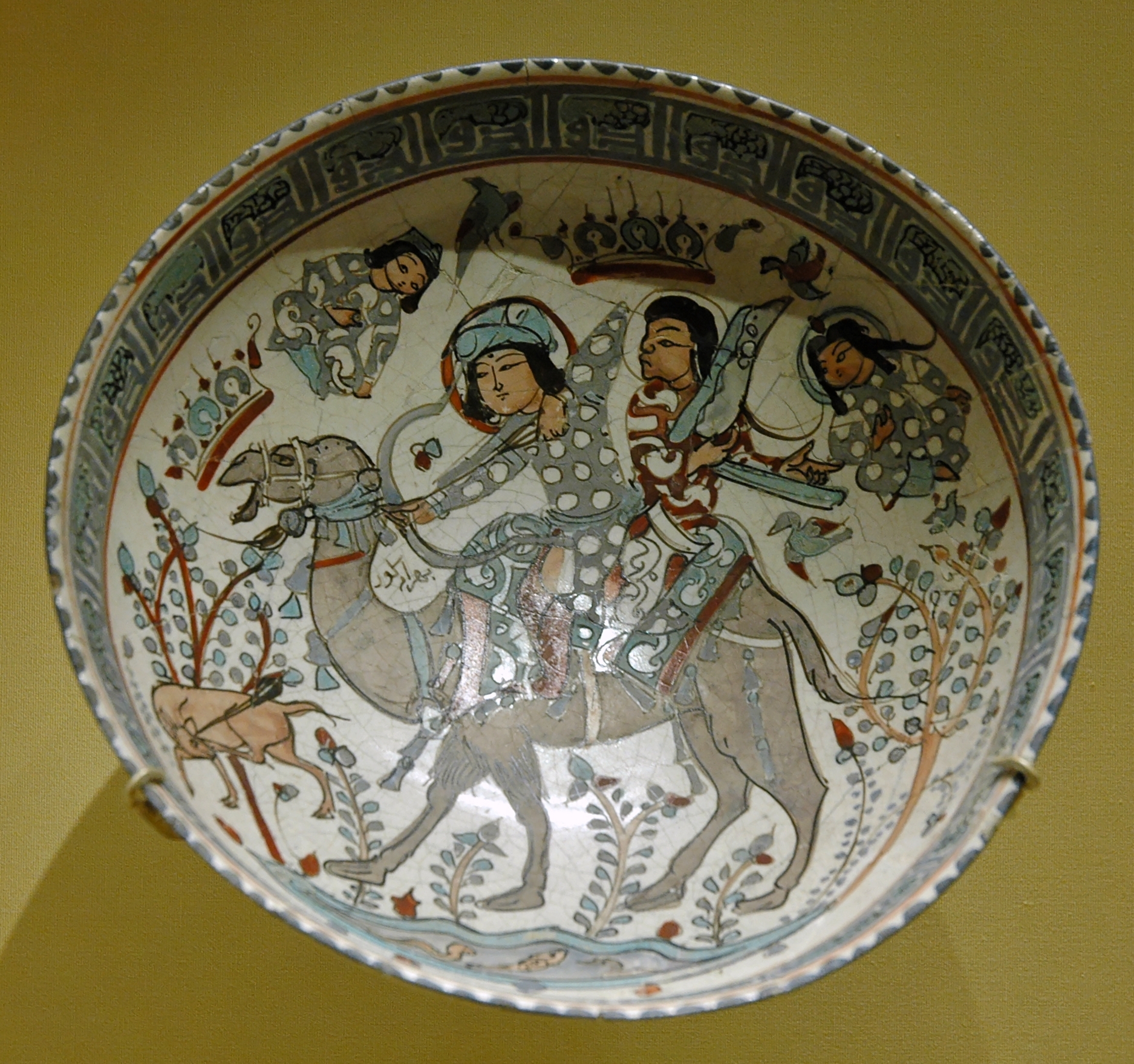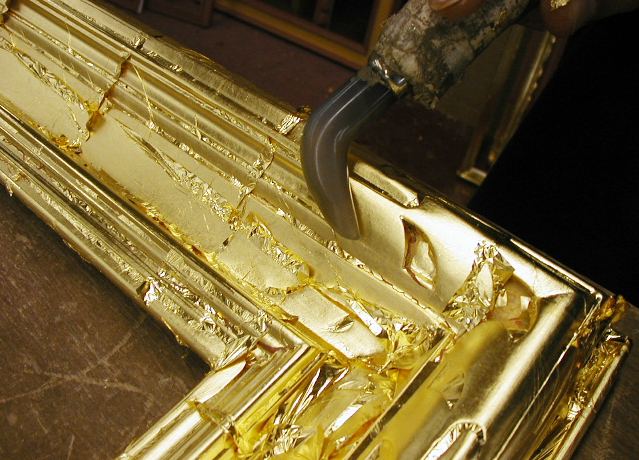|
Mina'i
ware is a type of Persian pottery, or Islamic pottery, developed in Kashan in the decades leading up to the Mongol invasion of Persia and Mesopotamia in 1219, after which production ceased. It has been described as "probably the most luxurious of all types of ceramic ware produced in the eastern Islamic lands during the medieval period". The ceramic body of white-ish fritware or stonepaste is fully decorated with detailed paintings using several colours, usually including figures. It is significant as the first pottery to use overglaze enamels, painted over the ceramic glaze fixed by a main glost firing; after painting the wares were given a second firing at a lower temperature. "" (), a term only used for these wares much later, means "enamelled" in the Persian language. The technique is also known as ''haft-rang'', "seven colours" in Persian. This term was used by the near-contemporary writer Abu al-Qasim Kasani, who had a pottery background. This technique much later beca ... [...More Info...] [...Related Items...] OR: [Wikipedia] [Google] [Baidu] |
Persian Pottery
Persian pottery or Iranian pottery is the pottery made by the artists of Persia (Iran) and its history goes back to early Neolithic Age (7th millennium BCE). Agriculture gave rise to the baking of clay, and the making of utensils by the people of Iran. Through the centuries, Persian potters have responded to the demands and changes brought by political turmoil by adopting and refining newly introduced forms and blending them into their own culture. This innovative attitude has survived through time and influenced many other cultures around the world. There were two types of earthenware that were prevalent in Iran around 4,000 BC: red and black ceramics that were simplistic in their decorative style. As the art expanded, earthenware incorporated geometric designs which resulted in a more developed decorative style. This increasingly complex style was accompanied by the creation of a wider variety of the kinds of pottery that were made. In the prehistoric period, the productio ... [...More Info...] [...Related Items...] OR: [Wikipedia] [Google] [Baidu] |
Overglaze Enamels
Overglaze decoration, overglaze enamelling, or on-glaze decoration, is a method of decorating pottery, most often porcelain, where the coloured decoration is applied on top of the already fired and glazed surface, and then fixed in a second firing at a relatively low temperature, often in a muffle kiln. It is often described as producing "enamelled" decoration. The colours fuse onto the glaze, so the decoration becomes durable. This decorative firing is usually done at a lower temperature which allows for a more varied and vivid palette of colours, using pigments which will not colour correctly at the high temperature necessary to fire the porcelain body. Historically, a relatively narrow range of colours could be achieved with underglaze decoration, where the coloured pattern is applied before glazing, notably the cobalt blue of blue and white porcelain. Many historical styles, for example mina'i ware, Imari ware, Chinese doucai, and wucai, combine the two types of deco ... [...More Info...] [...Related Items...] OR: [Wikipedia] [Google] [Baidu] |
Haft-rang
''Haft-rang'' ("seven colours") is a Persian term for a decorative technique for underglazed ceramic tiles. This decorative technique is also sometimes described as "''cloisonné''", "'' cuerda seca''" or "black line". The process begins with the application of multiple colours on square tiles coated with a white glaze. The colours are delineated with black painting so that they do not bleed into each other. Finally, the whole tile is fired in one step. This technique is decorative and relatively easy to deploy, especially compared to ''Mo'araq'', but it does not permit an optimum firing process for each of the colours. Hence the colours are weaker, less intense, less clearly delineated, and the glazes not as strong. Technique The ''Haft-rang'' technique for tiles only started to be used widely in the 17th century, although many examples are already known from the Timurid era, as in Gawhar Shad Madrasa (1418-1434) in Herat. Analysis of haft-rang tiles in Herat suggest the foll ... [...More Info...] [...Related Items...] OR: [Wikipedia] [Google] [Baidu] |
Islamic Pottery
Islamic pottery occupied a geographical position between Chinese ceramics, and the pottery of the Byzantine Empire and Europe. For most of the period, it made great aesthetic achievements and influence as well, influencing Byzantium and Europe. The use of drinking and eating vessels in gold and silver, the ideal in ancient Rome and Persia as well as medieval Christian societies, is prohibited by the Hadiths, with the result that pottery and glass were used for tableware by Muslim elites, as pottery (but less often glass) also was in China but was much rarer in Europe and Byzantium. In the same way, Islamic restrictions greatly discouraged figurative wall painting, encouraging the architectural use of schemes of decorative and often Islamic geometric patterns, geometrically patterned titles, which are the most distinctive and original speciality of Islamic ceramics. The era of Islamic pottery started around 622. From 633, Muslim armies moved rapidly towards Sassanid Empire, Pers ... [...More Info...] [...Related Items...] OR: [Wikipedia] [Google] [Baidu] |
Ilkhanate
The Ilkhanate or Il-khanate was a Mongol khanate founded in the southwestern territories of the Mongol Empire. It was ruled by the Il-Khans or Ilkhanids (), and known to the Mongols as ''Hülegü Ulus'' (). The Ilkhanid realm was officially known as the Land of Iran or simply Iran. It was established after Hulegu Khan, Hülegü, the son of Tolui and grandson of Genghis Khan, inherited the West Asian and Central Asian part of the Mongol Empire after his brother Möngke Khan died in 1259. The Ilkhanate's core territory was situated in what is now the countries of Iran, Azerbaijan, and Turkey. At its greatest extent, the Ilkhanate also included parts of modern Iraq, Syria, Armenia, Georgia (country), Georgia, Afghanistan, Turkmenistan, Pakistan, part of modern Dagestan, and part of modern Tajikistan. Later Ilkhanid rulers, beginning with Ghazan in 1295, converted to Islam. In the 1330s, the Ilkhanate was ravaged by the Black Death. The last ilkhan, Abu Sa'id Bahadur Khan, died in 133 ... [...More Info...] [...Related Items...] OR: [Wikipedia] [Google] [Baidu] |
Gilding
Gilding is a decorative technique for applying a very thin coating of gold over solid surfaces such as metal (most common), wood, porcelain, or stone. A gilded object is also described as "gilt". Where metal is gilded, the metal below was traditionally silver in the West, to make silver-gilt (or ''vermeil'') objects, but gilt-bronze is commonly used in China, and also called ormolu if it is Western. Methods of gilding include hand application and gluing, typically of gold leaf, chemical gilding, and electroplating, the last also called gold plating. Parcel-gilt (partial gilt) objects are only gilded over part of their surfaces. This may mean that all of the inside, and none of the outside, of a chalice or similar vessel is gilded, or that patterns or images are made up by using a combination of gilt and ungilted areas. Gilding gives an object a gold appearance at a fraction of the cost of creating a solid gold object. In addition, a solid gold piece would often be too soft or to ... [...More Info...] [...Related Items...] OR: [Wikipedia] [Google] [Baidu] |
Ceramic Slip
A ceramic is any of the various hard, brittle, heat-resistant, and corrosion-resistant materials made by shaping and then firing an inorganic, nonmetallic material, such as clay, at a high temperature. Common examples are earthenware, porcelain, and brick. The earliest ceramics made by humans were fired clay bricks used for building house walls and other structures. Other pottery objects such as pots, vessels, vases and figurines were made from clay, either by itself or mixed with other materials like silica, hardened by sintering in fire. Later, ceramics were glazed and fired to create smooth, colored surfaces, decreasing porosity through the use of glassy, amorphous ceramic coatings on top of the crystalline ceramic substrates. Ceramics now include domestic, industrial, and building products, as well as a wide range of materials developed for use in advanced ceramic engineering, such as semiconductors. The word ''ceramic'' comes from the Ancient Greek word (), meaning "of ... [...More Info...] [...Related Items...] OR: [Wikipedia] [Google] [Baidu] |
Lustreware
Lustreware or lusterware (the respective spellings for British English and American English) is a type of pottery or porcelain with a metallic glaze that gives the effect of iridescence. It is produced by metallic oxides in an Ceramic glaze, overglaze finish, which is given a second firing at a lower temperature in a "Muffle furnace, muffle kiln", or a Redox, reduction kiln, excluding oxygen. The technique of lustreware on pottery was first developed in Mesopotamia (modern Iraq) in the early 9th century. Initially mostly decorated with geometric patterns, by the 10th century an Iraqi style with the design dominated by one or two large figures developed. After the Fatimid conquest of Egypt in 969, it became a great centre of lustreware production until the Fatimid Caliphate fell in 1171, soon after the potter's quarter of the capital Fustat (Cairo) was burned in 1169. It is thought that the Fustat potters dispersed to both Syria (region), Syria and Greater Iran, Persia, and lustrew ... [...More Info...] [...Related Items...] OR: [Wikipedia] [Google] [Baidu] |





